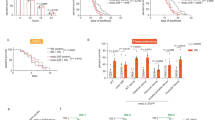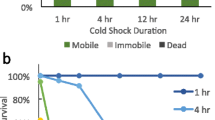Abstract
Mild hormetic heat treatments early in life can significantly increase the lifespan of the nematode C. elegans. We have examined the effects of heat treatments at different ages and show that treatments early in life cause the largest increases in lifespan. We also find that repeated mild heat treatments throughout life have a larger effect on lifespan compared to a single mild heat treatment early in life. We hypothesize that the magnitude of the hormetic effect is related to the levels of heat shock protein expression. Following heat treatment young worms show a dramatic increase in the levels of the small heat shock protein HSP-16 whereas old worms are a 100-fold less responsive. The levels of the heat shock proteins HSP-4 and HSP-16 correlate well with the effects on lifespan by the hormetic treatments.
Similar content being viewed by others
Abbreviations
- UPR:
-
unfolded protein response
- ER:
-
endoplasmic reticulum
- HSP:
-
heat shock protein
- GFP:
-
green fluorescent protein
References
Beedholm R, Clark BF, Rattan SI (2004) Mild heat stress stimulates 20S proteasome and its 11S activator in human fibroblasts undergoing aging in vitro. Cell Stress Chaperones 9:49–57
Brenner S (1974) The genetics of Caenorhabditis elegans. Genetics 77:71–94
Butov A, Johnson T, Cypser J, Sannikov I, Volkov M, Sehl M, Yashin A (2001) Hormesis and debilitation effects in␣stress experiments using the nematode worm Caenorhabditis elegans: the model of balance between cell damage and HSP levels. Exp Gerontol 37:57–66
Calfon M, Zeng H, Urano F, Till JH, Hubbard SR, Harding HP, Clark SG, Ron D (2002) IRE1 couples endoplasmic reticulum load to secretory capacity by processing the XBP-1 mRNA. Nature 415:92–96
Choi HS, Lin Z, Li BS, Liu AY (1990) Age-dependent decrease in the heat-inducible DNA sequence-specific binding activity in human diploid fibroblasts. J Biol Chem 265:18005–18011
Cypser J, Johnson TE (2001) Hormesis extends the correlation between stress resistance and life span in long-lived mutants of Caenorhabditis elegans. Hum Exp Toxicol 20:295–296
Cypser JR, Johnson TE (2002) Multiple stressors in Caenorhabditis elegans induce stress hormesis and extended longevity. J Gerontol A Biol Sci Med Sci 57:B109–B114
Cypser JR, Johnson TE (2003) Hormesis in Caenorhabditis elegans dauer-defective mutants. Biogerontology 4:203–214
Dillin A, Crawford DK, Kenyon C (2002) Timing requirements for insulin/IGF-1 signaling in C. elegans. Science 298:830–834
Dorman JB, Albinder B, Shroyer T, Kenyon C (1995) The age-1 and daf-2 genes function in a common pathway to control the lifespan of Caenorhabditis elegans. Genetics 141:1399–1406
Fawcett TW, Sylvester SL, Sarge KD, Morimoto RI, Holbrook NJ (1994) Effects of neurohormonal stress and aging on the activation of mammalian heat shock factor 1. J Biol Chem 269:32272–32278
Gil EB, Malone LE, Liu LX, Johnson CD, Lees JA (1999) Regulation of the insulin-like developmental pathway of Caenorhabditis elegans by a homolog of the PTEN tumor suppressor gene. Proc Natl Acad Sci USA 96:2925–2930
Guarente L, Kenyon C (2000) Genetic pathways that regulate ageing in model organisms. Nature 408:255–262
Hamilton B, Dong Y, Shindo M, Liu W, Odell I, Ruvkun G, Lee SS (2005) A systematic RNAi screen for longevity genes in C. elegans. Genes Dev 19:1544–1555
Hansen M, Hsu AL, Dillin A, Kenyon C (2005) New genes tied to endocrine, metabolic, and dietary regulation of lifespan from a Caenorhabditis elegans Genomic RNAi Screen. PLoS Genet. 1:119–128
Hercus MJ, Loeschcke V, Rattan SI (2003) Lifespan extension of Drosophila melanogaster through hormesis by repeated mild heat stress. Biogerontology 4:149–156
Heydari AR, Wu B, Takahashi R, Strong R, Richardson A (1993) Expression of heat shock protein 70 is altered by age and diet at the level of transcription. Mol Cell Biol 13:2909–2918
Hsu AL, Murphy CT, Kenyon C (2003) Regulation of aging and age-related disease by DAF-16 and heat-shock factor. Science 300:1142–1145
Johnson TE, de Castro E, Hegi de Castro S, Cypser J, Henderson S, Tedesco P (2001) Relationship between increased longevity and stress resistance as assessed through gerontogene mutations in Caenorhabditis elegans. Exp Gerontol 36:1609–1617
Khazaeli AA, Tatar M, Pletcher SD, Curtsinger JW (1997) Heat-induced longevity extension in Drosophila. I. Heat treatment, mortality, and thermotolerance. J Gerontol A Biol Sci Med Sci 52:B48–B52
Kimura KD, Tissenbaum HA, Liu Y, Ruvkun G (1997) daf-2, an insulin receptor-like gene that regulates longevity and diapause in Caenorhabditis elegans. Science 277:942–946
Kristensen TN, Sorensen JG, Loeschcke V (2003) Mild heat stress at a young age in Drosophila melanogaster leads to increased Hsp70 synthesis after stress exposure later in life. J Genet 82:89–94
Le Bourg E, Minois N, Bullens P, Baret P (2000) A mild stress due to hypergravity exposure at young age increases longevity in Drosophila melanogaster males. Biogerontology 1:145–155
Lee RY, Hench J, Ruvkun G (2001) Regulation of C. elegans DAF-16 and its human ortholog FKHRL1 by the daf-2 insulin-like signaling pathway. Curr Biol 11:1950–1957
Lin K, Dorman JB, Rodan A, Kenyon C (1997) daf-16: an HNF-3/forkhead family member that can function to double the life-span of Caenorhabditis elegans. Science 278:1319–1322
Lithgow GJ, White TM, Hinerfeld DA, Johnson TE (1994) Thermotolerance of a long-lived mutant of Caenorhabditis elegans. J Gerontol Biol Sci 49:B270–B276
Lithgow GJ, White TM, Melov S, Johnson TE (1995a) Thermotolerance and extended life span conferred by single-gene mutations and induced by thermal stress. Proc Natl Acad Sci USA 92:7540–7544
Lithgow GJ, White TM, Melov S, Johnson TE (1995b) Thermotolerance and extended life-span conferred by single-gene mutations and induced by thermal stress. Proc Natl Acad Sci USA 92:7540–7544
Mihaylova VT, Borland CZ, Manjarrez L, Stern MJ, Sun H (1999) The PTEN tumor suppressor homolog in Caenorhabditis elegans regulates longevity and dauer formation in an insulin receptor-like signaling pathway. Proc Natl Acad Sci USA 96:7427–7432
Morley JF, Morimoto RI (2004) Regulation of longevity in Caenorhabditis elegans by heat shock factor and molecular chaperones. Mol Biol Cell 15:657–664
Morris JZ, Tissenbaum HA, Ruvkun G (1996) A phosphatidylinositol-3-OH kinase family member regulating longevity and diapause in Caenorhabditis elegans. Nature 382:536–539
Norry FM, Loeschcke V (2003) Heat-induced expression of a molecular chaperone decreases by selecting for long-lived individuals. Exp Gerontol 38:673–681
Ogg S, Paradis S, Gottlieb S, Patterson GI, Lee L, Tissenbaum HA, Ruvkun G (1997) The Fork head transcription factor DAF-16 transduces insulin-like metabolic and longevity signals in C. elegans. Nature 389:994–999
Ogg S, Ruvkun G (1998) The C. elegans PTEN homolog, DAF-18, acts in the insulin receptor-like metabolic signaling pathway. Mol Cell 2:887–893
Rattan SI (1998) Repeated mild heat shock delays ageing in cultured human skin fibroblasts. Biochem Mol Biol Int 45:753–759
Rea SL, Wu D, Cypser JR, Vaupel JW, Johnson TE (2005) A stress-sensitive reporter predicts longevity in isogenic populations of Caenorhabditis elegans. Nat Genet 37:894–898
Rouault JP, Kuwabara PE, Sinilnikova OM, Duret L, Thierry-Mieg D, Billaud M (1999) Regulation of dauer larva development in Caenorhabditis elegans by daf- 18, a homologue of the tumour suppressor PTEN [In Process Citation]. Curr Biol 9:329–332
Solari F, Bourbon-Piffaut A, Masse I, Payrastre B, Chan AM, Billaud M (2005) The human tumour suppressor PTEN regulates longevity and dauer formation in Caenorhabditis elegans. Oncogene 24:20–27
Sorensen JG, Loeschcke V (2002) Decreased heat-shock resistance and down-regulation of Hsp70 expression with increasing age in adult Drosophila melanogaster. Funct Ecol 16:379–384
Terman A, Brunk UT (1998) Lipofuscin: mechanisms of formation and increase with age. APMIS 106:265–276
Tissenbaum HA, Ruvkun G (1998) An insulin-like signaling pathway affects both longevity and reproduction in Caenorhabditis elegans. Genetics 148:703–717
Urano F, Calfon M, Yoneda T, Yun C, Kiraly M, Clark SG, Ron D (2002) A survival pathway for Caenorhabditis elegans with a blocked unfolded protein response. J Cell Biol 158:639–646
Verbeke P, Clark BF, Rattan SI (2000) Modulating cellular aging in vitro: hormetic effects of repeated mild heat stress on protein oxidation and glycation. Exp Gerontol 35:787–794
Verbeke P, Clark BF, Rattan SI (2001) Reduced levels of oxidized and glycoxidized proteins in human fibroblasts exposed to repeated mild heat shock during serial passaging in vitro. Free Radic Biol Med 31:1593–1602
Verbeke P, Deries M, Clark BF, Rattan SI (2002) Hormetic action of mild heat stress decreases the inducibility of protein oxidation and glycoxidation in human fibroblasts. Biogerontology 3:117–120
Walker GA, Lithgow GJ (2003) Lifespan determination in C. elegans by Insulin-like regulation of a molecular chaperone. Aging Cell 2:131–139
Walker GA, White TM, McColl G, Jenkins NL, Babich S, Candido EP, Johnson TE, Lithgow GJ (2001) Heat shock protein accumulation is upregulated in a long-lived mutant of Caenorhabditis elegans. J Gerontol A Biol Sci Med Sci 56:B281–B287
Wheeler JC, Bieschke ET, Tower J (1996) Muscle-specific expression of Drosophila hsp70 in response to aging and oxidative stress. Proc Natl Acad Sci USA 92:10408–10412
Yashin AI, Cypser JR, Johnson TE, Michalski AI, Boyko SI, Novoseltsev VN (2001) Ageing and survival after different doses of heat shock: the results of analysis of data from stress experiments with the nematode worm Caenorhabditis elegans. Mech Ageing Dev 122:1477–1495
Yashin AI, Cypser JW, Johnson TE, Michalski AI, Boyko SI, Novoseltsev VN (2002) Heat shock changes the heterogeneity distribution in populations of Caenorhabditis elegans: does it tell us anything about the biological mechanism of stress response? J Gerontol A Biol Sci Med Sci 57:B83–B92
Yokoyama K, Fukumoto K, Murakami T, Harada S, Hosono R, Wadhwa R, Mitsui Y, Ohkuma S (2002) Extended longevity of Caenorhabditis elegans by knocking in extra copies of hsp70F, a homolog of mot-2 (mortalin)/mthsp70/Grp75. FEBS Lett 516:53–57
Acknowledgements
We thank Dr. Mette Lund and the members of the Lithgow Laboratory for helpful discussions. A. O. was supported by the Danish Cancer Society. G. J. L. is supported by NIH, the Ellison Medical Foundation, the Glenn Foundation for Medical Research and the Herbert Simon Family Medical Foundation.
Author information
Authors and Affiliations
Corresponding author
Rights and permissions
About this article
Cite this article
Olsen, A., Vantipalli, M.C. & Lithgow, G.J. Lifespan extension of Caenorhabditis elegans following repeated mild hormetic heat treatments. Biogerontology 7, 221–230 (2006). https://doi.org/10.1007/s10522-006-9018-x
Received:
Accepted:
Published:
Issue Date:
DOI: https://doi.org/10.1007/s10522-006-9018-x




